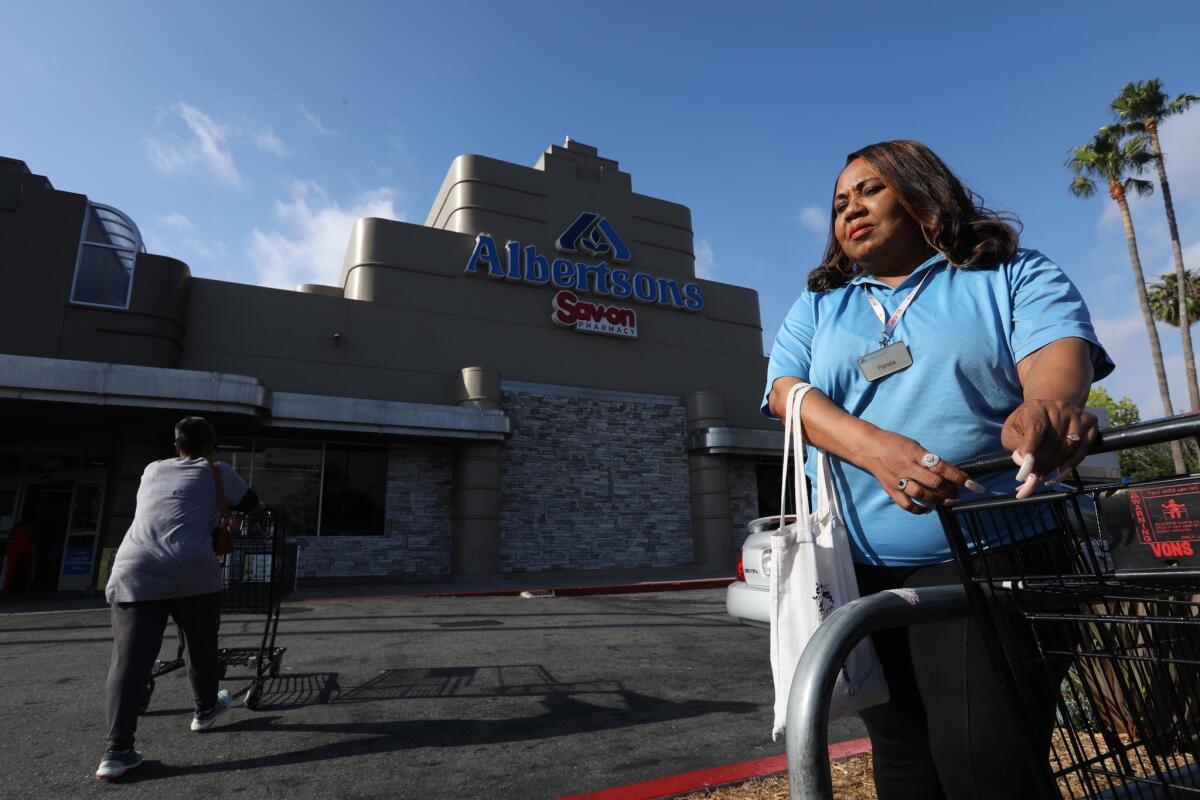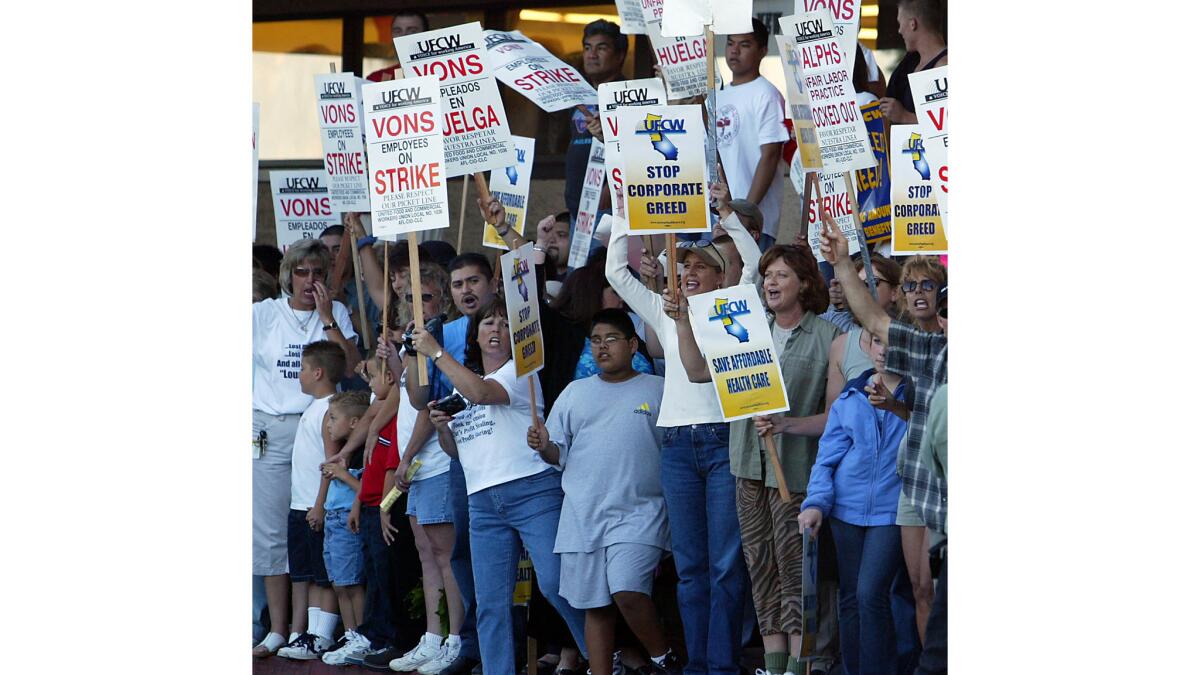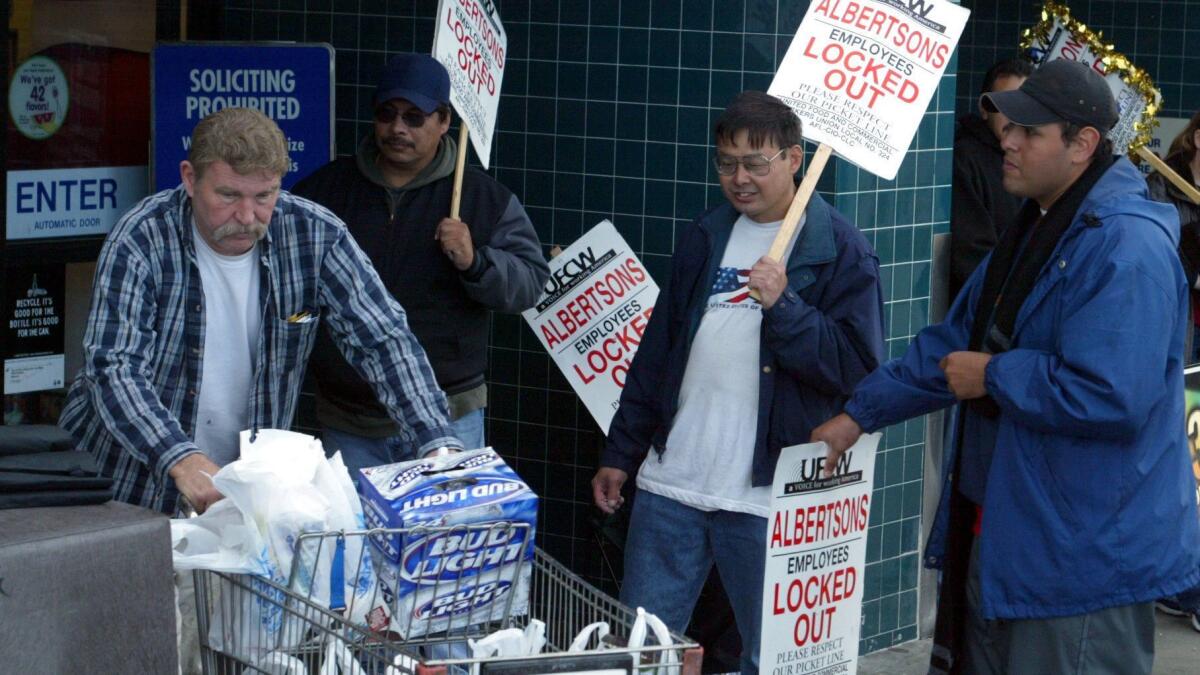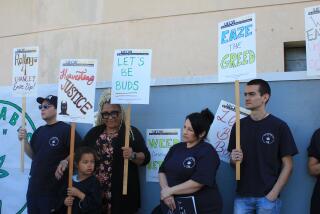Grocery strike rocked Southern California 16 years ago. It may happen again soon

Nearly 16 years ago, the largest and longest supermarket strike in U.S. history reshaped the Southern California grocery industry.
Tens of thousands of workers at Albertsons, Vons, Pavilions and Ralphs stores spanning from San Diego to San Luis Obispo went on strike or were locked out, starting in October 2003 and lasting more than four months.
Grocery shoppers had to choose whether to walk past workers picketing in the cold. Those who did found shelves often half-empty as they sought groceries for Thanksgiving, then Christmas.
Others looked elsewhere, flocking to Trader Joe’s or Costco — and forming new shopping habits that boosted those chains’ fortunes.
During the strike, the chains in the labor dispute lost a combined $1.5 billion in sales.
And now it might happen again.
Early next week, members of the United Food and Commercial Workers union in Southern and Central California plan to vote on whether to authorize another strike, this time by 46,000 unionized workers. Negotiations have stalled on a new contract with Albertsons — which now owns Vons and Pavilions — and Ralphs.
The vote doesn’t necessarily mean a strike will happen. But if approved, it would enable the union to call a strike whenever it wants. That approval would send a message to the companies that a walkout is possible if the two sides can’t reach a deal. The employees are still working under a three-year contract that expired March 3.
Pamela Hill, 58, a 23-year veteran of Albertsons who works at its store on Crenshaw Boulevard near Los Angeles’ Baldwin Hills area, is ready to send that message. A cashier and safety trainer, she plans to vote yes on authorizing the UFCW to strike.
“I was ready in 2003, but I’m more ready now because I’m at the age where I’m looking forward to my retirement in a few years,” Hill said. “I want my benefits and pensions and so forth to be intact.”
Albertsons, Vons and Pavilions have a combined 342 stores and 29,000 unionized employees in Southern California. Ralphs, a division of Kroger Co., has 190 stores and 17,000 employees involved.
Albertsons said in a statement to the Los Angeles Times that the strike vote is “premature and will cause our employees and customers undue concerns.”
“Nevertheless, we hope to get back to the bargaining table and reach an agreement soon,” Albertsons said, adding that it wants a contract that’s “fair to our employees, good for our customers and allows Albertsons, Vons and Pavilions to remain competitive in the Southern California market.”
The most recent talks were June 10 and 11, and the sides are scheduled to meet again from July 10 to 12, said Ralphs, which is negotiating together with Albertsons for the same master contract.
If there is a strike, Southern Californians would have more options than they did 16 years ago in the fiercely competitive grocery business.
Mass merchants Walmart Inc., Costco Wholesale Corp. and Target Corp. now have sizable grocery sections. Discount chains Aldi and Grocery Outlet have opened stores in the region. Whole Foods Market — now owned by Amazon.com Inc. — is still an option, as are Trader Joe’s, Gelson’s Market, Sprouts and Stater Bros. Ethnic and organic markets fill the region too.
While shopping at a Ralphs in Los Angeles’ Pico-Robertson neighborhood this week, Fraida Gutovich, 64, of Beverly Hills said she would shift to the “multiple kosher markets” in the area if a strike occurs because “they’ve got great produce and great meat.”
But Gutovich also noted that she shops at her Ralphs regularly — “they know me very well here,” she said — which illustrated how a walkout would again send shock waves through the region’s grocery sector.
That’s because Albertsons’ chains and Ralphs still dominate. The Shelby Report, a publication that tracks the industry, says Albertsons is the largest player in the Southern California/Las Vegas region, with 19.8% of the market. Kroger, which includes Ralphs and Food 4 Less, is next at 18.6%.

A strike “would be very disruptive because most consumers shop out of convenience,” said Bob Reeves, the Shelby Report’s vice president for the West.
“If they’ve got an Albertsons around the corner, they probably shop there whether they like it or not,” he said. “As soon as it becomes inconvenient, they’ll go a mile or two to shop somewhere else.
“Ralphs and Albertsons are well aware of that. That’s why it’s in their best interests to resolve this as soon as possible,” Reeves said. “They’re definitely going to lose customers.”
One would be Rob Munn, 56, of Inglewood. While shopping at his local Ralphs this week, Munn said he would not cross a picket line. “I respect what they’re fighting for, as far as [the] cost of living,” he said of the employees. “It’s really hard out here.”
The union is making the same case in the contract talks, where the primary issue is wages, and claiming the stores are limiting workers’ ability to earn much more than the rising minimum wage.
But the grocery workers also receive healthcare and pension benefits that many other minimum-wage jobs don’t provide.
Not all the workers are eager to walk out, including Irma Franco, 59, a deli clerk at a Ralphs in Inglewood who has been with the chain 13 years. “I don’t want to strike,” she said, despite having her own complaints about how work hours are divided among newer and more experienced employees. “I want my job and I want to work.”

Main categories of grocery workers involved are meat cutters and two kinds of clerks. Depending on their years of service, the expired contract they’re still using calls for meat cutters to earn between $13.34 and $23.23 an hour this year; the category of clerks that includes cashiers, between $12.40 and $20.95; and another kind of clerks, between $12.20 and $15.37. Department managers, who are also unionized, earn more.
The low end of those wage scales is higher in Los Angeles and certain other areas where local governments have implemented a minimum wage above the state’s level of $12 an hour for medium and large employers. In those cases, the grocery workers start with a wage that’s typically at least 20 cents an hour higher than the legally mandated minimum, the UFCW said.
In Los Angeles, minimum wage will rise to $14.25 an hour on July 1 for medium and large employers and to $15 an hour next year. The statewide minimum wage will hit $15 an hour in 2022.
Albertsons and Ralphs are offering raises of less than 1% a year in the negotiations for a new three-year contract — “below the cost of living,” said Mike Shimpock, a spokesman for UFCW Local 770 in Los Angeles, one of seven locals involved in the contract talks.
In the 12-month period that ended in May, the consumer price index in the Los Angeles area rose 3.1% in part due to high housing costs, according to the Bureau of Labor Statistics.
He said Ralphs also wants to move cashiers from the higher-paid clerk category to the lesser-paid one. The UFCW not only objects to that switch, it also wants to narrow the wage gap between the two categories overall because employees in both sectors often do the same work, Shimpock said.
“These are successful companies that can afford to pay their employees more to put food on the table and pay the rent, but that’s not what they’re doing,” Shimpock said, noting that under the current contract, an experienced cashier in Los Angeles is earning less than $45,000 a year.
The median rent in Los Angeles County is now $2,471 a month — $29,652 a year, according to a report by the California Housing Partnership.
Albertsons, based in Boise, Idaho, is owned by an investor group led by Cerberus Capital Management, and it acquired Safeway Inc. — the former parent of Vons and Pavilions — in 2015. Albertsons has about 2,269 stores in 34 states, and it reported profit of $131 million on sales of $60.5 billion in fiscal 2018.
Ralphs’ parent Kroger, based in Cincinnati, is publicly held and owns several grocery chains. Kroger, with 2,764 stores overall, reported sales of $121.8 billion in fiscal 2018 and profit of $1.7 billion after adjusting for the sale of its convenience-store business and other items.
Neither Albertsons nor Ralphs would comment on the union’s complaints about the stores’ contract offers. But Ralphs spokesman John Votava said in a statement to The Times that “we are negotiating in good faith with the union for a fair and balanced contract that is good for our associates, as well as our company.”
“Negotiations are about finding compromise, and this can take time,” Votava said.
In a recent message to its employees, Ralphs said it is “committed to providing good, stable jobs and competitive pay and benefits,” but that it also needs “to keep our stores competitive in this changing retail environment.”
Albertsons and Ralphs are under pressure to limit labor-cost gains because grocery profit margins are historically thin and the stores are competing against many non-union rivals such as Walmart, said Andrew Wolf, a retail analyst at Loop Capital Markets.
“If I’m a non-union supermarket operator, it’s just cheaper for me to be in business because I don’t have the extra costs of unionization, including healthcare and pensions,” Wolf said. And without those added costs, “I don’t have to raise my prices to cover them,” he said, which gives the non-union stores a competitive advantage.
That concern was at the heart of the dispute 16 years ago, when Albertsons and Ralphs were trying to keep labor costs down in the face of Walmart and other mass merchants aggressively moving into groceries.
The strike began Oct. 11, 2003, when UFCW members who worked at Vons and Pavilions walked off the job. Because Ralphs and Albertsons were bargaining jointly with those chains, they locked out their workers in solidarity.
The struggle ended Feb. 29, 2004, when union members ratified a new contract that provided, among other things, reduced wages and healthcare benefits for new hires. The two-tier setup for wages was discarded with a later contract, but it remains for healthcare and pension benefits, the UFCW said.
“If we had not gone on strike and been locked out in 2003-04, the assault on grocery workers would have been ferocious” in subsequent contracts, the UFCW’s Shimpock said. “The act of standing up for ourselves showed we had the will that’s helped protect us during the years.”
Hill, the Albertsons worker, said that while the strike and lockout “was hard for us, it was very necessary because, had we not put our foot down and said, ‘No, this is not going to happen,’ then the contracts that we’ve had since then would have gotten worse and worse.”
Back then, “people were apprehensive” about a strike, “they were scared, didn’t know how they’d pay bills,” Hill said. “People weren’t really taking the necessary precautions in case we did go on strike.”
“But this time around,” she said, “it seems like people are more ready than ever.”







